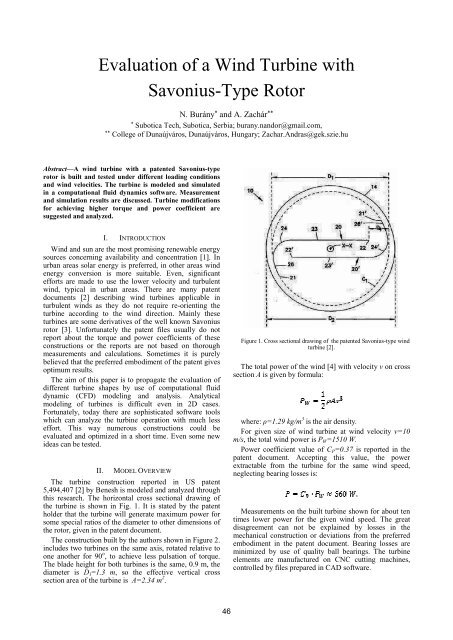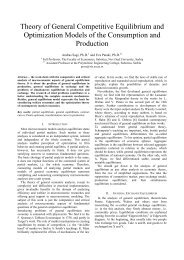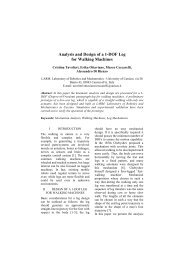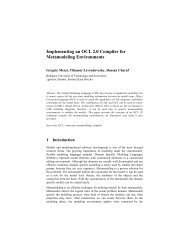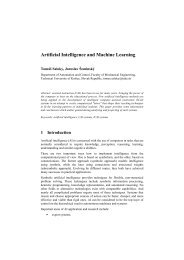Final Program EXPRES 2012 - Conferences
Final Program EXPRES 2012 - Conferences
Final Program EXPRES 2012 - Conferences
- No tags were found...
You also want an ePaper? Increase the reach of your titles
YUMPU automatically turns print PDFs into web optimized ePapers that Google loves.
Evaluation of a Wind Turbine withSavonius-Type RotorN. Burány * and A. Zachár ***Subotica Tech, Subotica, Serbia; burany.nandor@gmail.com,**College of Dunaújváros, Dunaújváros, Hungary; Zachar.Andras@gek.szie.huAbstract—A wind turbine with a patented Savonius-typerotor is built and tested under different loading conditionsand wind velocities. The turbine is modeled and simulatedin a computational fluid dynamics software. Measurementand simulation results are discussed. Turbine modificationsfor achieving higher torque and power coefficient aresuggested and analyzed.I. INTRODUCTIONWind and sun are the most promising renewable energysources concerning availability and concentration [1]. Inurban areas solar energy is preferred, in other areas windenergy conversion is more suitable. Even, significantefforts are made to use the lower velocity and turbulentwind, typical in urban areas. There are many patentdocuments [2] describing wind turbines applicable inturbulent winds as they do not require re-orienting theturbine according to the wind direction. Mainly theseturbines are some derivatives of the well known Savoniusrotor [3]. Unfortunately the patent files usually do notreport about the torque and power coefficients of theseconstructions or the reports are not based on thoroughmeasurements and calculations. Sometimes it is purelybelieved that the preferred embodiment of the patent givesoptimum results.The aim of this paper is to propagate the evaluation ofdifferent turbine shapes by use of computational fluiddynamic (CFD) modeling and analysis. Analyticalmodeling of turbines is difficult even in 2D cases.Fortunately, today there are sophisticated software toolswhich can analyze the turbine operation with much lesseffort. This way numerous constructions could beevaluated and optimized in a short time. Even some newideas can be tested.II.MODEL OVERVIEWThe turbine construction reported in US patent5,494,407 [2] by Benesh is modeled and analyzed throughthis research. The horizontal cross sectional drawing ofthe turbine is shown in Fig. 1. It is stated by the patentholder that the turbine will generate maximum power forsome special ratios of the diameter to other dimensions ofthe rotor, given in the patent document.The construction built by the authors shown in Figure 2.includes two turbines on the same axis, rotated relative toone another for 90 o , to achieve less pulsation of torque.The blade height for both turbines is the same, 0.9 m, thediameter is D 1 =1.3 m, so the effective vertical crosssection area of the turbine is A=2.34 m 2 .Figure 1. Cross sectional drawing of the patented Savonius-type windturbine [2].The total power of the wind [4] with velocity v on crosssection A is given by formula:where: ñ=1.29 kg/m 3 is the air density.For given size of wind turbine at wind velocity v=10m/s, the total wind power is P W =1510 W.Power coefficient value of C P =0.37 is reported in thepatent document. Accepting this value, the powerextractable from the turbine for the same wind speed,neglecting bearing losses is:Measurements on the built turbine shown for about tentimes lower power for the given wind speed. The greatdisagreement can not be explained by losses in themechanical construction or deviations from the preferredembodiment in the patent document. Bearing losses areminimized by use of quality ball bearings. The turbineelements are manufactured on CNC cutting machines,controlled by files prepared in CAD software.46


